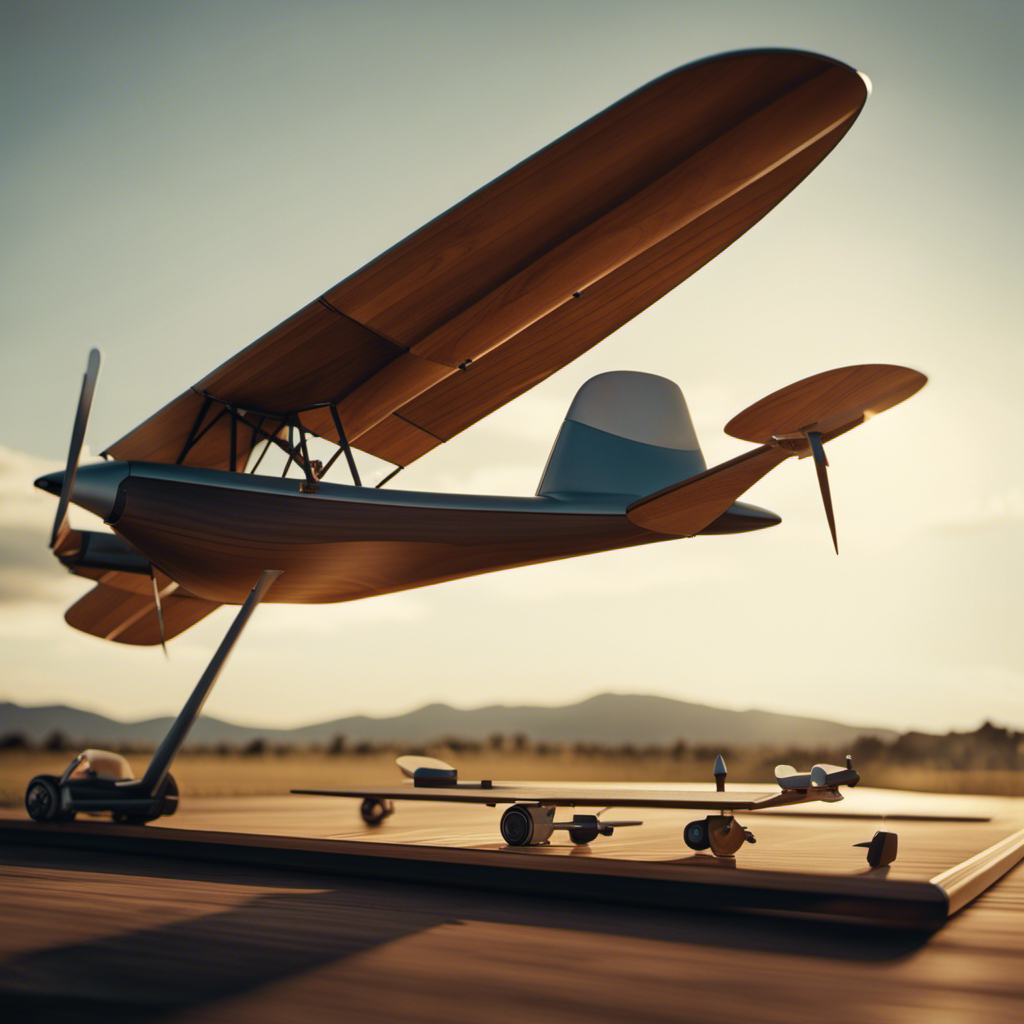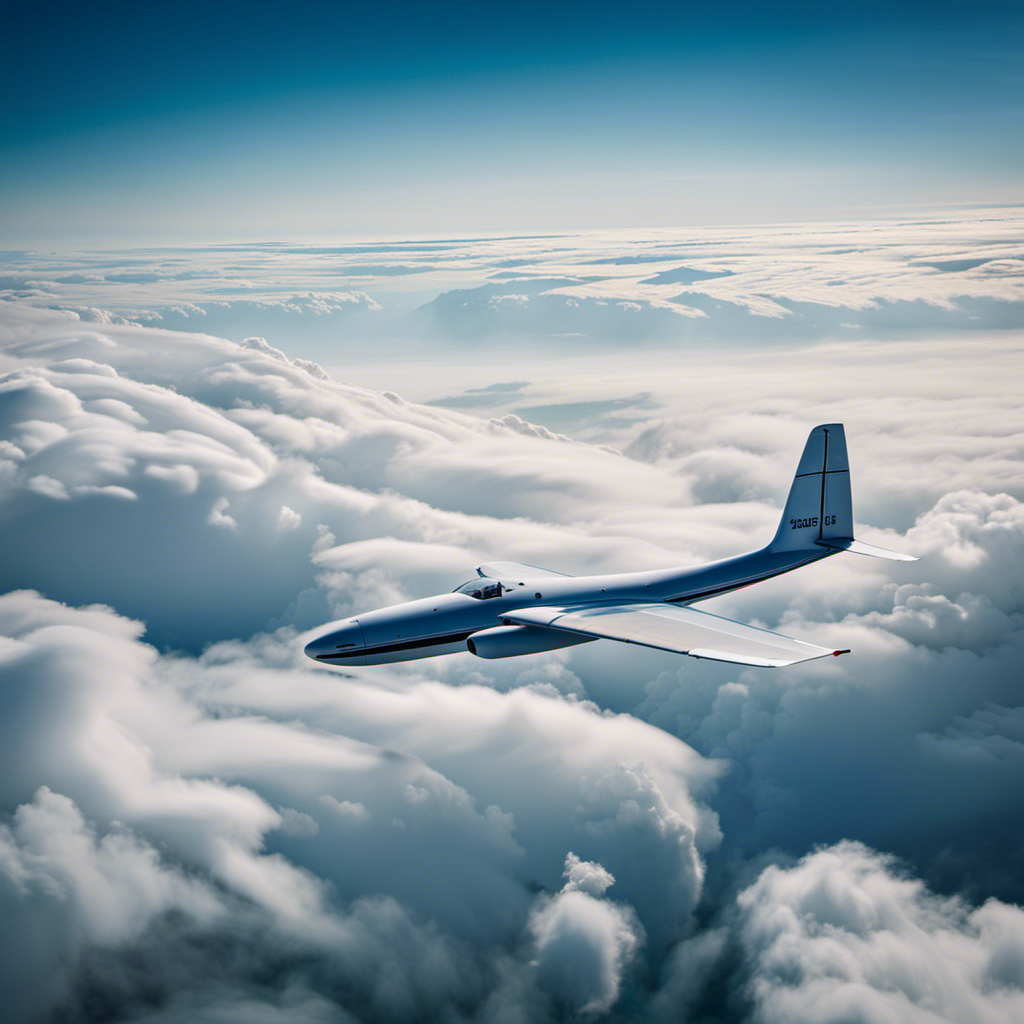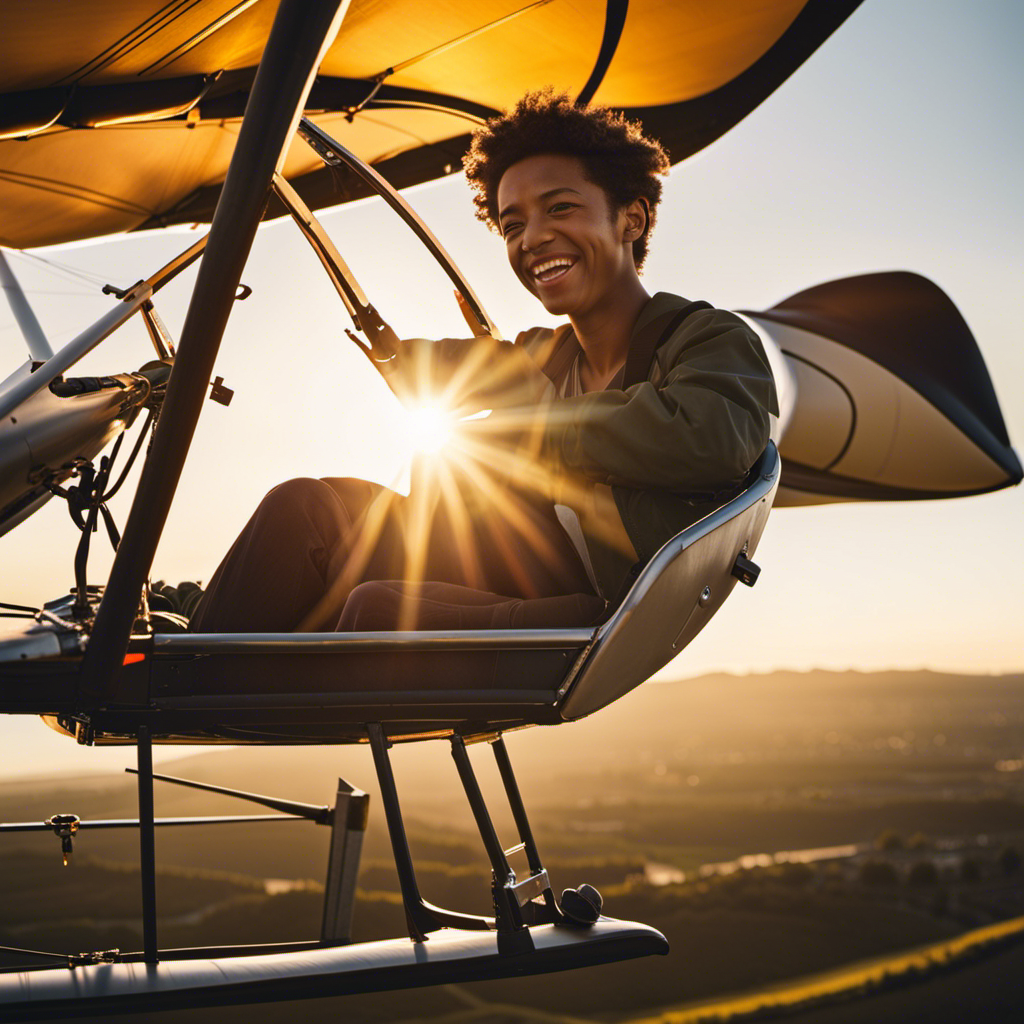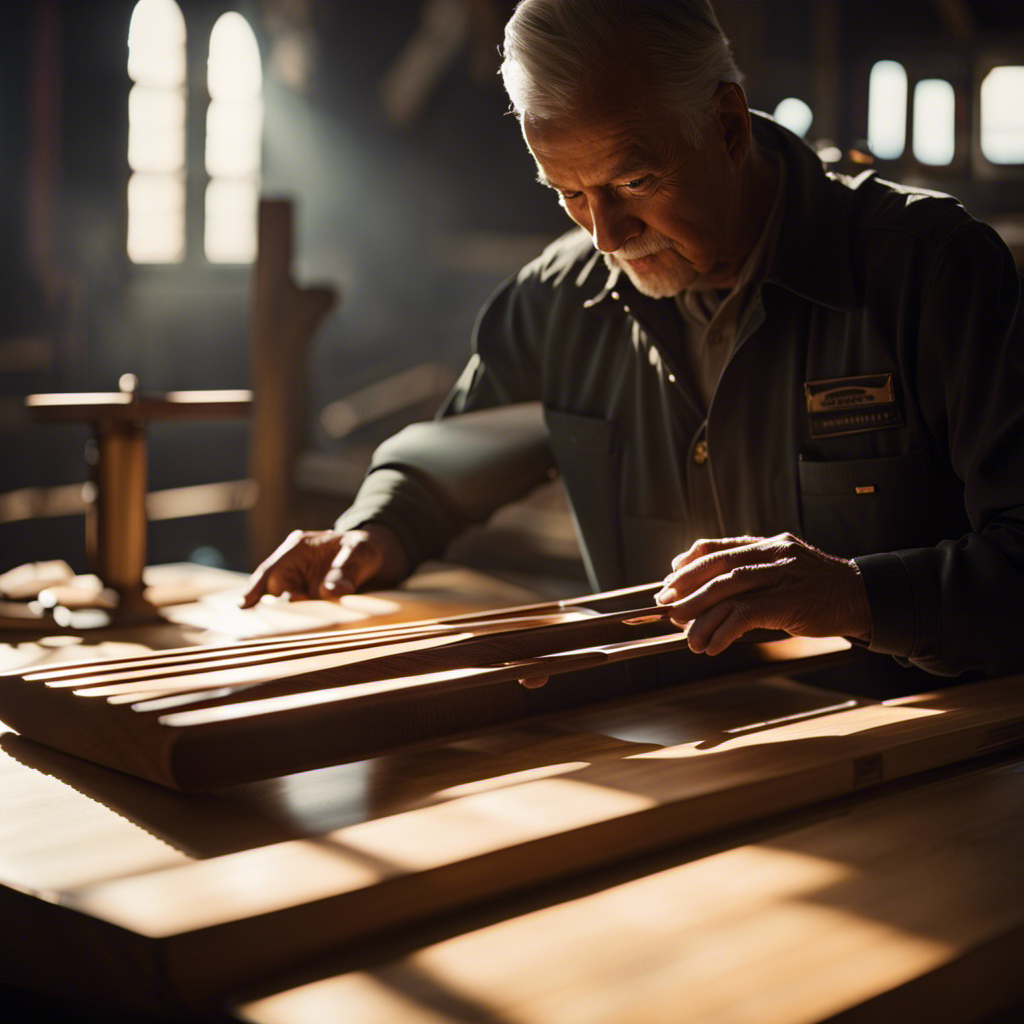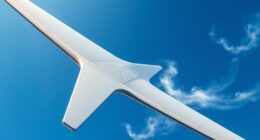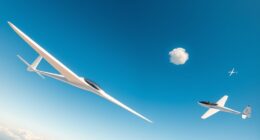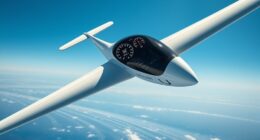Did you know that modern gliders have come a long way from their humble beginnings? They have evolved into sleek and efficient machines that can smoothly glide through the sky.
In this article, we’ll explore the fascinating journey of glider development over time. From the pioneering work of the Wright Brothers to the advancements in design and materials, we’ll delve into the world of competitive gliding, record-breaking flights, and the safety measures in place.
So buckle up and get ready to discover the incredible evolution of modern gliders.
Key Takeaways
- Advancements in glider design have led to improved performance, safety, and self-launching capabilities.
- Notable record-breaking glider flights demonstrate progress in glider technology and showcase pilot skill and capabilities.
- Safety and training are of utmost importance in gliding, with extensive training in aerodynamics, emergency procedures, and adherence to regulations.
- Gliding as a recreational activity offers freedom of flight, serenity in the air, connection with nature, and challenges in mastering soaring and reliance on elements.
Early Origins of Gliders
The early origins of gliders can be traced back to the experiments of early aviation pioneers. These pioneers were fascinated by the idea of human flight and sought to find ways to defy gravity.
One of the first notable figures in the field of gliding was Sir George Cayley, an English engineer who designed and built a series of gliders in the early 19th century. His designs incorporated a fixed wing, a tail, and a control system, laying the foundation for modern glider design.
Another important figure was Otto Lilienthal, a German aviation pioneer who made significant advancements in glider design and control in the late 19th century. His experiments and meticulous observations of bird flight led to the development of efficient glider wings and control surfaces.
These early experiments paved the way for the Wright Brothers and the birth of modern gliding.
The Wright Brothers and the Birth of Modern Gliding
Contrary to popular belief, the Wright Brothers didn’t invent gliding, but they did play a pivotal role in its modern birth. Before the Wright Brothers, gliders were crude and unstable, often resulting in fatal accidents. However, the brothers, Orville and Wilbur, brought a new level of precision and control to gliding. Through meticulous observations and countless experiments, they developed a three-axis control system that allowed pilots to maneuver their gliders with greater stability. This breakthrough was a game-changer, revolutionizing the world of gliding and laying the foundation for modern aircraft design. The following table highlights the key contributions of the Wright Brothers to glider technology:
| Contribution | Description | Impact |
|---|---|---|
| Three-axis control system | Provided greater stability and control | Revolutionized glider technology |
| Systematic testing and experimentation | Led to valuable insights and improvements | Enhanced safety and performance |
| Development of wind tunnels | Enabled accurate aerodynamic testing | Facilitated optimal design refinement |
With the Wright Brothers’ advancements, glider design and materials continued to evolve, leading to even more remarkable achievements in the field.
Advances in Glider Design and Materials
Despite popular misconceptions, the Wright Brothers’ contributions to gliding went beyond just the development of a three-axis control system. Their advancements in glider design and materials played a crucial role in the evolution of modern gliders.
They experimented with various wing shapes, sizes, and camber to achieve maximum lift and efficiency. They also introduced the use of lightweight yet strong materials, such as spruce and fabric, which allowed for greater maneuverability and durability.
These innovations paved the way for future glider designers to explore new possibilities in aerodynamics and materials. The Wright Brothers’ work laid the foundation for the understanding of soaring and the discovery of lift, which would later lead to the development of modern gliders capable of sustained flight without the need for a motor.
Soaring and the Discovery of Lift
To understand soaring and the discovery of lift, you can explore the Wright Brothers’ pioneering work in glider design and materials. Their experiments in the early 1900s laid the foundation for our understanding of aerodynamics and how objects can stay aloft.
Here are four fascinating aspects of soaring and lift that will captivate your interest:
- Bernoulli’s Principle: Discover how differences in air pressure create lift.
- Angle of Attack: Learn how changing the angle between the wing and the oncoming air affects lift.
- Thermals: Explore how warm air rising in columns can provide gliders with upward lift.
- Ridge Lift: Find out how wind blowing against a mountain or hill can create lift.
With these concepts in mind, we can delve into the realm of competitive gliding and the development of racing classes, where pilots push the limits of glider performance and efficiency.
Competitive Gliding and the Development of Racing Classes
Competitive gliding has seen significant advancements in terms of racing classes, allowing pilots to explore the boundaries of glider performance and efficiency.
In the past, gliding competitions were relatively simple, with all gliders competing in a single class. However, as the sport has grown and evolved, various racing classes have been introduced to cater to different types of gliders and pilot skills.
These classes are based on factors such as wing loading, maximum takeoff weight, and the presence of motorized propulsion. The introduction of racing classes has not only made competitions more fair and competitive, but it has also spurred innovation in glider design.
Pilots and manufacturers are constantly striving to create gliders that excel in specific racing classes, pushing the limits of aerodynamics, materials, and technology. This focus on competition has led to significant advancements in glider performance and efficiency.
Transitioning into the subsequent section about the impact of technology on glider design, these advancements have been made possible by the continuous integration of cutting-edge technologies in glider construction and aerodynamics.
The Impact of Technology on Glider Design
With advancements in technology, glider design has been significantly influenced and improved. Today, modern gliders are more efficient, durable, and capable than ever before. Here are five ways technology has shaped the evolution of gliders:
-
Lightweight Materials: Carbon fiber composites and other lightweight materials have replaced traditional materials like wood and metal, reducing the glider’s weight and increasing its performance.
-
Aerodynamic Enhancements: Computer simulations and wind tunnel testing have allowed designers to optimize the glider’s shape, reducing drag and improving its overall aerodynamic efficiency.
-
Advanced Instrumentation: GPS navigation systems, variometers, and advanced flight instruments provide pilots with real-time data on weather conditions, airspace, and performance, enhancing safety and navigation.
-
Improved Safety Features: Modern gliders are equipped with safety systems such as ballistic recovery parachutes and reinforced cockpit structures to protect pilots in case of emergencies.
-
Electric Propulsion: Electric motor systems are being integrated into gliders, allowing for self-launching capabilities and extending the range of cross-country flights.
As technology continues to advance, glider design will undoubtedly continue to progress, pushing the boundaries of performance and safety.
Now, let’s explore the fascinating world of record-breaking glider flights.
Record-Breaking Glider Flights
Imagine soaring through the sky, breaking altitude records in a state-of-the-art glider that’s equipped with cutting-edge technology. Modern gliders have come a long way from their humble beginnings, pushing the boundaries of what is possible in aviation. These record-breaking flights showcase the incredible capabilities of these aircraft and the skill of the pilots who fly them.
Here are three notable glider flights that have set new records:
| Record | Pilot | Distance |
|---|---|---|
| Altitude Record | Einar Enevoldson | 52,172 feet |
| Distance Record | Klaus Ohlmann | 1,478.6 miles |
| Speed Record | Sebastian Kawa | 176.15 mph |
Einar Enevoldson, a former NASA test pilot, reached an astounding altitude of 52,172 feet in 2018, setting a new world record. Klaus Ohlmann, a renowned glider pilot, holds the distance record, flying a staggering 1,478.6 miles in 2003. Sebastian Kawa set the speed record, reaching an impressive speed of 176.15 mph in 2016.
These incredible feats demonstrate the remarkable progress in glider technology and the skill of the pilots who push the limits. Safety and training in gliding are crucial aspects to ensure the success and well-being of glider pilots, allowing them to continue breaking records and achieving new heights.
Safety and Training in Gliding
Safety and training are crucial aspects of gliding, ensuring your well-being and success as you strive to break records and achieve new heights. Gliding may seem like a serene and effortless activity, but it requires careful preparation and knowledge to navigate the skies safely.
Before taking flight, you must complete extensive training to understand the principles of aerodynamics, weather patterns, emergency procedures, and proper handling of the glider. This training includes both theoretical and practical components, allowing you to develop the necessary skills to control the aircraft and respond to any unexpected situations.
Additionally, safety measures such as pre-flight inspections, regular maintenance, and adherence to established regulations are essential to minimize risks. By prioritizing safety and investing in proper training, you can enjoy the thrill of gliding while minimizing potential dangers.
Transitioning into the subsequent section about ‘gliding as a recreational activity,’ it is important to note that safety and training are equally important for both record-breaking endeavors and leisurely gliding adventures.
Gliding as a Recreational Activity
Transitioning into the realm of leisurely activities, gliding offers a unique and exhilarating experience for those seeking adventure in the sky. As you soar through the air, suspended in a graceful glider, you can’t help but marvel at the beauty of the world beneath you. But what exactly makes gliding such a compelling recreational activity?
-
Gliding allows you to experience the freedom of flight without the noise and vibration of an engine. It offers a sense of serenity and tranquility as you glide effortlessly through the air, feeling the wind on your face.
-
Gliding provides an opportunity to connect with nature and appreciate the stunning landscapes from a bird’s-eye view. It challenges you to master the art of soaring, relying on the elements and your skill to stay airborne.
As you delve deeper into the world of gliding, it becomes clear that this activity has evolved significantly over time. But what does the future hold for gliders?
The Future of Gliders
In the future of gliders, you can expect to see the rise of electric-powered gliders. These gliders offer a more sustainable and environmentally-friendly alternative to traditional gliders. They are equipped with electric motors that provide efficient and quiet propulsion. This reduces the reliance on fossil fuels and minimizes noise pollution.
Advancements in autonomous glider technology are also making it possible for gliders to fly without human intervention. These gliders rely on sophisticated sensors and algorithms to navigate and make decisions during flight. This technology is constantly improving and has the potential to revolutionize the glider industry.
Electric-powered gliders
You can now experience the thrill of soaring through the skies in electric-powered gliders. These innovative aircraft have revolutionized the world of gliding, offering a sustainable and quiet alternative to traditional gliders.
Electric-powered gliders rely on electric motors, which are powered by batteries, to provide the necessary thrust for takeoff and climb. Once airborne, the gliders utilize their sleek design and efficient aerodynamics to maintain speed and altitude.
The electric propulsion system not only reduces the environmental impact but also enhances the overall performance of the glider, allowing pilots to explore new heights and distances. With advancements in battery technology, the range and endurance of electric-powered gliders are continuously improving, paving the way for longer and more exciting flights.
As we delve into the advancements in autonomous glider technology, we witness how innovation and technology are reshaping the future of gliding.
Advancements in autonomous glider technology
Imagine being able to sit back and relax as an autonomous glider effortlessly navigates through the skies, using cutting-edge technology to soar to new heights. Autonomous glider technology has made significant advancements in recent years, revolutionizing the world of aviation.
Here are three key advancements that have contributed to the development of autonomous gliders:
-
Artificial Intelligence (AI): Autonomous gliders now incorporate AI algorithms that enable them to make real-time decisions based on environmental conditions, optimizing their flight paths for maximum efficiency and safety.
-
Sensors and Cameras: Advanced sensors and cameras are integrated into autonomous gliders, providing crucial data on airspeed, altitude, and weather conditions. This information is used to make precise adjustments to the glider’s flight trajectory.
-
Communication Systems: Autonomous gliders are equipped with sophisticated communication systems that enable them to receive updates on air traffic, weather patterns, and other relevant information. This allows them to navigate through crowded airspace and avoid potential hazards.
These advancements in autonomous glider technology have opened up new possibilities for exploration, research, and even transportation, making the skies more accessible and safer than ever before.
Conclusion
Congratulations! You’ve now soared through the captivating history and evolution of modern gliders.
From the early origins to the groundbreaking discoveries, gliders have transformed into magnificent flying machines.
Just like a bird spreading its wings and embracing the sky, gliders have taken flight, pushing boundaries and breaking records.
With safety and training at the forefront, gliding has become a thrilling recreational activity for many.
So buckle up and prepare for the future, where gliders will continue to soar to new heights, like a phoenix rising from the ashes.
